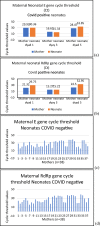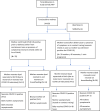Clinical profile, viral load, management and outcome of neonates born to COVID 19 positive mothers: a tertiary care centre experience from India
- PMID: 32910210
- PMCID: PMC7482055
- DOI: 10.1007/s00431-020-03800-7
Clinical profile, viral load, management and outcome of neonates born to COVID 19 positive mothers: a tertiary care centre experience from India
Abstract
Despite rapidly evolving knowledge about COVID 19 infection, routes of perinatal COVID 19 transmission and viral load in mother neonate dyad remain uncertain. Data were analysed to describe the clinicodemographic profile and viral load in neonates born to COVID 19 positive mothers. Of 2947 deliveries, 69 mothers were COVID 19 positive (2.3%), with 1 abortion, 2 macerated stillbirths and 2 fresh stillbirths as pregnancy outcomes. Of 65 tested neonates, 10.7% (7) were confirmed COVID 19 positive by RTPCR (reverse transcriptase-polymerase chain reaction). Viral load (cycle threshold, Ct of E, RDRp) in neonates was comparable with the Ct reported from adults; however, neonates had milder clinical manifestations. All 7 neonates who tested positive for COVID 19 were subsequently discharged. Six of the 7 neonates were asymptomatic and 1 neonate needed respiratory support (indication being prematurity) which resolved after 48 h. Maternal and neonatal comparison of Ct of E and RdRp gene was statistically non-significant (25.97 vs 19.68, p = 0.34 and 26.5 vs 25.0, p = 0.84). Viral loads of mothers with COVID 19 positive neonates compared with mothers with COVID 19 negative neonates for E and RdRp gene were also statistically non-significant (25 vs 27.19, p = 0.63 and 19.6 vs 27.6, p = 0.08). The majority (93%) of neonates tested later than 48 h (roomed in with mother and breastfed) tested negative.Conclusion: The study supports milder manifestation in COVID 19 positive neonates. Risk of transmission from COVID 19 positive mother to neonate by rooming-in and breastfeeding is low. In this study on a limited number of neonates, maternal viral load was not found to be associated with the positivity status or severity of the illness of neonate. What is Known: • Neonates born to COVID 19 positive mothers are at risk of COVID 19 infection. What is New: • Risk of transmission of COVID 19 from mother to neonate, with rooming-in and breastfeeding, appears low. • In this study on a limited number of neonates, maternal viral load of COVID 19 (E and RdRp cycle thresholds) was not associated with severity of illness or COVID 19 positivity in neonates.
Keywords: COVID 19; Clinical profile; Neonates; Viral load.
Conflict of interest statement
The authors declare that they have no conflict of interest.
Figures


References
-
- World Health Organization (WHO). WHO coronavirus disease 2019 (COVID-19) situation report 46. Available at: https://www.who.int/docs/default source/coronaviruse/situationreports/20.... Accessed 24th May 2020
-
- Chen H, Guo J, Wang C, Luo F, Yu X, Zhang W, Li J, Zhao D, Xu D, Gong Q, Liao J, Yang H, Hou W, Zhang Y. Clinical characteristics and intrauterine vertical transmission potential of COVID-19 infection in nine pregnant women: a retrospective review of medical records. Lancet. 2020;395:809–815. doi: 10.1016/S0140-6736(20)30360-3. - DOI - PMC - PubMed
-
- Zhang L, Jiang Y, Wei M, et al. Analysis of the pregnancy outcomes in pregnant women with COVID-19 in Hubei Province. Zhonghua Fu Chan Ke Za Zhi. 2020;55:E009. - PubMed
-
- Fan C, Lei D, Fang C et al (2020. In press) Perinatal transmission of COVID-19 associated SARS-CoV-2: Should we worry? Clin Infect Dis. 10.1093/cid/ciaa226
MeSH terms
LinkOut - more resources
Full Text Sources
Medical
Research Materials

